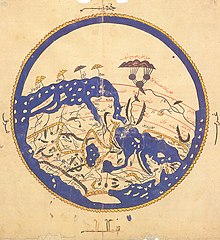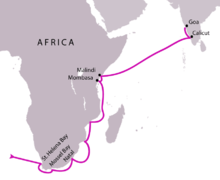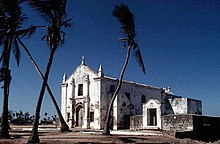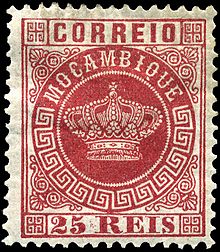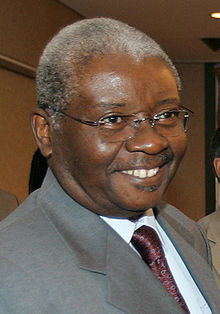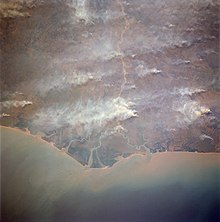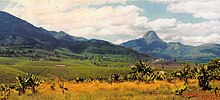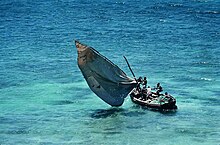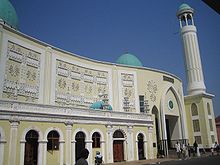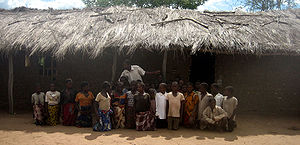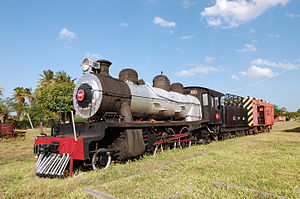Mozambique
Mozambique, officially the Republic of Mozambique (in Portuguese, República de Moçambique), is a country located southeast of Africa, on the shores of the Indian Ocean. It is bordered by Tanzania and Malawi to the north, Zambia to the northwest, Zimbabwe to the west, Swaziland to the southwest, South Africa to the south and southwest, and the Indian Ocean to the east, where it borders by sea with Madagascar, Comoros, and the French territories of Europa Island, Juan de Nova and Bassas da India. The origin of its name is Msumbiji, the Swahili port on the Island of Mozambique. Its territory is made up of eleven provinces, divided into one hundred twenty-eight districts. Its capital and most populous city is Maputo.
Between the 1st and 5th centuries, Bantu peoples migrated to present-day Mozambique from the north and west. Between the 7th and 11th centuries, Swahili port cities developed, contributing to the development of a Swahili culture and language of its own. In the late Middle Ages, these cities were frequented by merchants from Somalia, Ethiopia, Egypt, Arabia, Persia, and India. Vasco da Gama explored its coasts in 1498 and was colonized by Portugal in 1505. Mozambique gained independence in 1975, becoming shortly after in the People's Republic of Mozambique. The country was the scene of a civil war that lasted from 1977 to 1992, leaving two million landmines still active.[citation needed] In 1994, Mozambique held its first elections multi-party and has remained a relatively stable presidential republic ever since, although to date it faces a low-intensity insurgency.
The country is one of the poorest countries in the world, ranking low in GDP per capita, human development index, measures of inequality, and life expectancy, yet since the end of the civil war, its quality of life has improved markedly. Since 2001, Mozambique's economic growth has been among the highest in the world. The country's economy is based primarily on agriculture, with a growing tourism and industrial sector, focused primarily on food and beverages, chemical manufacturing, and aluminum and oil production.
Its official language is Portuguese, which is spoken mainly as a second language by about half the population. Common native languages include Makua, Makonde, and Swahili. More than 99% of the population of 31 million is Bantu, and their main religion is Christianity, with significant minorities following Islam and traditional African religions. The country is a member of the Community of Portuguese Language Countries, the African Union and the Commonwealth of Nations, being considered as an observer of the Francophonie.
Etymology
The Portuguese gave the name Mozambique, inspired by the island of Mozambique, which derives from Musa al Biq, Mossa al Bique or Mussa Ben Mbiki, an Arab merchant who visited and settled on said island.
History
Mozambique's first inhabitants were Khoisan hunters and gatherers, ancestors of the Khoikhoi peoples. Although not many hominid fossil remains have been found, it is reasonable to think that due to its location in the place where modern humans could have originated, the current territory of Mozambique has been populated for many thousands of years.
Several archaeological finds allow the study of crucial events in Mozambique's prehistory, such as the establishment of the Bantu peoples in the s. III a. C., who introduced metallurgy between the I and IV d. C. during its third phase of expansion. In addition to their iron working skills, the Bantu were good farmers, which led to a population explosion and consequent expansion. The best known of their administrative organizations was the Monomotapa Empire.
At the end of the s. x d. C., groups of nyika emerged in the central zone of Mozambique. A settlement known as Mapungubwe, which included many Nyikas, developed on the upper Limpopo River.
Arab and Asian explorers
In the s. X d. C., the explorer Al-Masudi described an important commercial activity in the Persian Gulf and in Bilad as Sofala.
For his part, the geographer Al Idrisi says that in the XII century the current province of Sofala was an important source of iron, gold and furs, also noting that at that time China and India already had stable trade relations with East Africa. Trading activity in these locations dates back to at least the s. IX d. C.
By the 13th century there were between thirty and forty Swahili city-states on the East African coast. In Mozambique, its extreme southern extension was the town of Angoche. Many present-day ports such as Mozambique Island, Ibo, and probably Inhambane, were built on former Swahili trading towns.
The Mozambique Channel is considered to be the furthest (western) point visited in the 1420s by the explorer Zheng He.
European colonization
Vasco da Gama's voyage around the Cape of Good Hope in 1498 marked Portugal's entry into Indian Ocean commerce, politics, and society. Indeed, since 1500 the Portuguese trading posts became permanent ports on the new route to the east, so that in 1505 the decision was made to occupy East Africa. In addition, in 1507 a permanent settlement was founded on the Island of Mozambique, achieving the goal of bringing the area under Portuguese control around 1530.
Controlled the port of Sofala at the beginning of the XVI century, groups of Portuguese merchants went in search of gold, organizing garrisons and trading posts at Vila de Sena y Tete on the Zambezi River, seeking to establish a monopoly.
During this period, the greatest threat to Portuguese hegemony was the Turks, who between 1538 and 1553 launched several attacks from the Red Sea and the Persian Gulf. These advances, however, failed due to difficulties supplying wood to build ships, and due to the Portuguese defensive efforts, which had the consequence of weakening its naval power to open a gap used by the British and Dutch to extend to the East. It belonged to Spain from 1580 to 1640, due to its union with Portugal. For their part, the French only began their explorations at the beginning of the 17th century , founding his French East India Company in 1664. In their eagerness to preserve their commercial monopoly and strategic interests in the area, the Portuguese did not hesitate to spread all kinds of fears to create an atmosphere of extreme hostility towards the other Europeans.
Peace was signed with the English (in 1635) and the Dutch (in 1640), prompted among others by the three Dutch defeats in the 1600s, in their attempts to establish themselves in the area, as well as by navigation difficulties presented by the Mozambique channel.
Portuguese consolidation
The Portuguese Empire succeeded in driving its European colonial competitors away from the shores of East Africa. The Portuguese tried to legitimize and consolidate their positions by creating prazos (concessions) attached to their administrative apparatus. Although the prazos were originally developed to be run by the Portuguese, through intermarriage they became Luso-African or Luso-indigenous centers, defended by black slaves called chikunda.
In Mozambique, slavery was practiced by African tribal chiefs, Arab traders, and Portuguese (prazeiros). In fact, between 1500 and 1800, about a million people were sold as slaves. slaves.
Although Portuguese influence expanded, its power was limited and exercised through a few officials and colonists, who were guaranteed a great deal of autonomy. If between 1500 and 1700 it was possible to control the Arab commercial expansion, with the fall of Fort Jesus on Mombasa Island in 1698 (currently belonging to Kenya), the Portuguese found themselves in a disadvantageous situation, and their power decreased. As a result, investment declined while Lisbon devoted itself to more lucrative deals with India and the Far East, as well as the colonization of Brazil.
18th and 19th centuries
During the 18th and XIX, the Mazrui and Omani Arabs controlled much of the maritime trade in the region, displacing the Portuguese influence to the south. By 1780, the Portuguese had lost all influence north of Cabo Delgado due to Omani advances. Many prazos were abandoned by mid-century XIX.
At this time, other colonial powers such as the British and French empires (the latter hailing from Madagascar) became increasingly involved in the trade and politics of Portuguese East Africa. In this sense, only with the division of Africa during the Berlin Conference in 1885, the Portuguese penetration was transformed into a military occupation, which took place during the first years of the century XX to a true colonial administration.
In effect, Portugal claimed a strip of land from Mozambique to Angola, which was accepted by the German imperial authorities, their colonial neighbors in northern German East Africa, but not by the British, who would also control the Tanganyika section. Due to the debts of the Portuguese, and the military capacity of both powers, in 1891 they were forced to renounce their claims and accept the lines defined by the British. In that sense, although the map of Mozambique was defined by the four centuries under Portuguese rule, the result is due more to a haphazard sequence of attempts at expansion than to successful policy.
20th century
By the early 20th century, the Portuguese had shifted most management to large private companies, such as Mozambique (current Manica and Sofala provinces), Zambezia or Niassa (current Cabo Delgado and Niassa), directed and financed mainly by the United Kingdom, which established railway lines to connect Beira with Nyasaland and Northern Rhodesia, and developed sugar, copra and sisal plantations.
Although slavery was officially abolished, in the late 19th century companies applied forced labor policies, supplying men for work in the mines and on plantations in neighboring British colonies, as well as in South Africa. The Zambezia Company, the most profitable, seized several prazeiros, and established military outposts. Roads, ports and other communication routes were built, in particular a railway linking Zimbabwe and the port of Beira.
Due to its poor results, under Salazar's Estado Novo, the control of the Portuguese Empire increased and the concessions were not renewed, for which reason the Niassa Company disappeared in 1929, and that of Mozambique in 1942. In 1951 all the colonies in Africa were renamed Provincias Ultramarinas de Portugal.
During this period the concentration of power in the hands of Portuguese companies and individuals intensified.
Independence
In the 1950s, the Portuguese launched a series of development plans to extend and modernize the national transportation and communications infrastructure. The good post-war prices for tropical products favored the economy, which was not favorable for the native population, which suffered severe mobility limitations due to the lack of opportunities, mainly caused by the arrival of Portuguese settlers, which worsened some already bad relations between the two communities.
As communist and anti-colonial ideologies spread across the continent, many pro-independence political movements were created for Mozambique. They claimed that because development policies and plans were designed to favor the Portuguese, too little attention had been paid to tribal integration and the development of their native communities.
The Mozambican Liberation Front (Frelimo) began a guerrilla war against the Portuguese regime in 1964. Along with fighting in Portuguese West Africa (present-day Angola) and Portuguese Guinea (present-day Guinea-Bissau), Mozambique was part of the Portuguese colonial war. By 1974 Frelimo could move in the northern area with ease, as well as in central areas, although the urban areas of most of the south and the coast were still in Portuguese hands. Frelimo does not expect the withdrawal of Portuguese troops of Angola to develop its own administration in the "liberated" regions. The number of schools and literacy is increasing, health centers are being created and agricultural crops are being developed, organized by the movement. In 1973, the first "party committees" were created, as well as the "Party School", responsible for the ideological training of its leaders. Although there is little documentation on the political organization of these regions, it seems that Frelimo has tried to encourage farmers to participate in decision-making instead of entrusting power to their representatives.
In 1975, both due to the guerrilla action and the effects of the Carnation Revolution in Portugal, Mozambique obtained its independence along with the rest of the regions that still belonged to its colonial Empire. At the same time, a civil war began between Frelimo, supported by the Soviet Union and Cuba, and the opposition Mozambican National Resistance (Renamo), supported by South Africa and the United States. The Samora Machel regime undertakes an authoritarian fight against tribalism and is trying to reduce the influence of religions, which will be poorly accepted by the population.
After the conflict
The civil war lasted fifteen years, extending from 1977 to 1992, the year in which a peace agreement was signed under the aegis of the United Nations between Frelimo and Renamo, with which the fighting ceased. The first group, which described itself as a Marxist-Leninist party, made significant concessions for the sake of the peace process. The country became a member of the World Bank and the International Monetary Fund in 1994, and adopted a market economy under a structural adjustment program.
In December 2004, Mozambique underwent a delicate transition when Joaquim Chissano, after eighteen years as president, stepped down. His successor, Armando Emílio Guebuza, promised to continue the successful economic policies that favored foreign investment, which explains —among other things— why since the end of the civil war there has been good economic growth, largely thanks to the reconstruction process and the cancellation of the debt.
One of the most difficult effects of the war is the existence of two million landmines in the country, especially in rural areas.
Politics
Mozambique is a semi-presidential republic, whose political party with a parliamentary majority composes and organizes the government. Elections are held every five years.
Frelimo was the movement that fought for national liberation since the beginning of the sixties. After independence, on June 25, 1975, the former guerrilla group came to control power. In 1978 it became a Marxist-Leninist political party and its leader, Samora Machel, held the presidency of the country in a one-party regime. He held the position since the country's independence, until his death in 1986. Since then, his successor Joaquim Chissano ruled until 2005.
Mozambique suffered a fifteen-year civil war, between 1977 and 1992, which was resolved with the peace agreement signed by the then President Joaquim Chissano, and Afonso Dhlakama, leader of the Mozambican National Resistance (Renamo).
In 1990 a new constitution was approved that transformed the state into a multi-party republic. Frelimo remains in power to this day, having won multi-party elections three times in 1994, 1999 and 2004. Renamo is the main opposition party.
The current President of Mozambique is Filipe Jacinto Nyussi, and its Prime Minister is Adriano Maleiane.
Human Rights
In terms of human rights, regarding membership of the seven bodies of the International Bill of Human Rights, which include the Human Rights Committee (HRC), Mozambique has signed or ratified:
In 2009 cases of serious human rights violations were registered: Press freedom is severely restricted and independent media are obstructed. Social problems such as domestic violence, discrimination against women, abuse, exploitation, forced labor of children and discrimination against sexual minorities and people living with HIV/AIDS continue to be widespread, as as documented in the annual human rights reports of the United States Department of State. Aggressions, discrimination, and acts of violence based on people's sexual orientation also continue to occur. Homosexuality has not been considered a criminal offense since 2015.
In 2016, human rights violations occurred during renewed fighting between government forces and RENAMO, according to reports. The expansion of a branch of the Islamic State terrorist group since 2015 further aggravates the human rights situation, especially in the north of the country.
Judicial system
Prison conditions are extremely harsh and have already led to several deaths. The courts are understaffed and the judges, insufficiently trained, work ineffectively and are influenced by the ruling party. According to Amnesty International, the police have used excessive force during demonstrations and when detaining criminal suspects. Thirteen detainees suffocated in police custody in an overcrowded cell. Two police officers had to be tried in this context. For an extrajudicial execution committed in 2007, a high-ranking police officer was convicted of murder.
Foreign Policy
While loyalties dating back to the liberation struggle remain relevant, Mozambique's foreign policy has become increasingly pragmatic. The two pillars of Mozambique's foreign policy are maintaining good relations with its neighbors and maintaining and expanding ties with development partners.
During the 1970s and early 1980s, Mozambique's foreign policy was inextricably linked to struggles for majority rule in Rhodesia and South Africa, as well as superpower competition and the Cold War. of Mozambique to apply UN sanctions against Rhodesia and deny that country access to the sea led the government of Ian Smith to take overt and covert action to oppose that country. Although the change of government in Zimbabwe in 1980 removed this threat, the South African government continued to destabilize Mozambique. Mozambique also belonged to the Front Line States.
The 1984 Nkomati Agreement, while failing to end South African support for RENAMO, opened the first diplomatic contacts between the governments of Mozambique and South Africa. This process gained momentum with South Africa's removal of apartheid, culminating in the establishment of full diplomatic relations in October 1993. Although relations with neighboring Zimbabwe, Malawi, Zambia and Tanzania show occasional strains, Mozambique's ties with these countries remain strong.
In the years immediately following its independence, Mozambique benefited from considerable aid from some Western countries, especially the Scandinavian ones. The Soviet Union and its allies became Mozambique's main economic, military, and political support, and its foreign policy reflected this linkage. This began to change in 1983; in 1984 Mozambique joined the World Bank and the International Monetary Fund. Western aid from the Scandinavian countries of Sweden, Norway, Denmark, and Iceland quickly replaced Soviet support. Finland and the Netherlands are becoming increasingly important sources of development aid. Italy also maintains a profile in Mozambique as a result of its key role during the peace process. Relations with Portugal, the former colonial power, remain important because Portuguese investors play a visible role in Mozambique's economy.
Mozambique is a member of the Non-Aligned Movement and ranks among the moderate members of the African bloc at the United Nations and other international organizations. Mozambique is also a member of the African Union (formerly the Organization of African Unity) and the Southern African Development Community. In 1994, the government became a full member of the Organization of the Islamic Conference, partly to broaden its international support base, but also to please the country's sizeable Muslim population. Also, in 1995 Mozambique joined its Anglophone neighbors in the Commonwealth of Nations. At the time it was the only nation to have joined the Commonwealth that had never been part of the British Empire. That same year, Mozambique became a founding member and first president of the Community of Portuguese Language Countries (CPLP), and maintains close ties with other Portuguese-speaking countries.
Territorial organization
The territory of Mozambique is divided into eleven provinces, made up of one hundred and twenty-eight districts, divided in turn into four hundred and five postos, which are made up of localities, which constitute the smallest national administrative unit. Some of its districts are Góndola, Gorongosa, Guro, Macanga, Mauá, Panda, Ribáuè and Xai-Xai. Its capital and main commercial, financial and social center is the port city of Maputo.
- Map of the provinces of Mozambique
|  |
Geography
Mozambique is the 52nd most populous country and the 36th largest in the world, with a population of about 21 million people, and an area of 799,380 km² . For comparative purposes, its population corresponds to half that of Colombia, and its total area to that of Turkey, or broad lines, double that of Paraguay or California.
The country is located on the East African coast, on the continent's largest coastal plain (half of the country's territory is 230 m a.s.l.). The mountain range known as Inyanga is located in the west of the country. The highest mountain elevations are found near Zimbabwe, Zambia and Malawi. Mount Binga, in the province of Manica, with its 2,436 m altitude, constitutes the 26th highest mountainous territory in Africa, and the highest point in all of Mozambique. Other relevant mountains are Gorongosa (with 1,862 m, located in a 4,000 km² nature park in Sofala), Mount Domue (at 2,095 m in Tete), Mount Chiperone (at 2,052 m), and Mount Namuli (at 2,419 m in the western border region of Zambezia). None of these elevations is, however, within the highest mountains of the continent.
In the Mozambique channel, it is neighboring the Comoros and Madagascar, as well as the French territories of Réunion, Mayotte, Juan de Nova, Bassas da Índia, Gloriosa Islands and Europa Island.
The coasts are very irregular, covered by large swamps, the terrain rising as you move towards the west. In the border states with Malawi and Zambia are the highest regions of the entire country. Some of the localities located in the highlands are Chimoio, Angónia and Lichinga. In its southern zone is the Bay of Maputo, inside which is the national capital.
The country is divided by the Zambezi River. Its valley, located at the southern end of the Great Rift Valley, is the most important of the geographical features on a national scale. Other important watercourses are the Rovuma River (on the border with Tanzania), the Komati River (between Cape Delgado and Nampula), the Save River (between Sofala and Inhambane), as well as the Limpopo, Maputo, Komati, Shire and Usutu rivers. In its northwestern part it includes a part of Lake Malawi. For its part, the Cahora Bassa reservoir is the second largest artificial lake in Africa, located in the province of Tete. The retaining wall is 171 m high and 303 m wide and its reservoir capacity amounts to 510 million cubic meters.
Climate
The savannah climate predominates with a wet season and a dry season. In the rainy season, which lasts from November to April, about 80% of the annual rainfall falls. Depending on the region, this varies between 700 and 1500 mm per year. While temperatures during the rainy season are hot and humid (tropical), the dry season is characterized by much cooler nights. Throughout the year, daytime temperatures range between 25 and 30 °C, and inland they reach 35 °C. The nights are sometimes very humid, between 15 and 25 °C, especially on the coast.
In some years, such as 2007/2008, unusually high rainfall occurred, claiming lives and threatening crops. In general, the country experiences a high degree of climate variability and frequent extreme weather events (especially droughts, floods and tropical cyclones). Droughts are the most common disasters, occurring approximately every three to four years and greatly hampering the country's development. Regarding the consequences of global warming, it is assumed that cyclones may be less frequent, but their intensity is likely to increase and, therefore, rainfall. In 2019, for example, Cyclones Idai and Kenneth were unusually intense and caused extensive damage. These weather events can also cause increased erosion in coastal areas. Since a large part of the population, and especially many poor people in rural areas, depend on rainfed agriculture for their subsistence, they are especially vulnerable to changes in the rainfall pattern.
Ecoregions
In the territory of Mozambique there are twelve ecoregions. Due to the civil war, its flora and bird life are little known, and it is also in a critical state of conservation due to logging and the uncontrolled extension of the agricultural frontier and grazing areas. Several ecoregions are included in the Global 200 list.
The Inhambane coastal mosaic forest is a shady forest, which extends from the Lukuledi River, in southern Tanzania, to the Changane River, near the mouths of the Limpopo, thus occupying a good part of the national coastline in the Cabo Delgado, Nampula and Zambezia provinces, as well as a section of Inhambane. Nestled in this ecoregion are sections of East African mangrove, with its largest area found in the Zambezi River delta, as well as Zambezi brackish, in the Changane Valley, in the southern provinces of Gaza and Inhambane.
In a region shared with Tanzania and Malawi is the eastern miombo woodland, which has miombo vegetation adapted to the dry climate and poor soils. It occupies the interior areas of the provinces of Cabo Delgado, Niassa and Tete.
The Zambezi flooded coastal savannah, in the delta of the Zambezi and other nearby rivers, is a flooded grassland. It lies entirely in the Mozambican province of Sofala. It was profoundly altered by the construction of the Cahora Bassa and Kariba dams.
The Zambezi flooded prairie, in the province of Zambezia and around Malawian Lake Chilwa, is a very rich wetland area for feeding mammals and birds.
To the northwest, the Southern Rift montane grassland-jungle mosaic, in the mountains west of Lake Malawi, is a montane grassland at the southern end of the Great Rift Valley.
For its part, the southern miombo woodland is relatively intact because more than 45% of its territory corresponds to state and private reserves. In Mozambique, in the state of Inhambane, there is, for example, the Limpopo National Park. That ecoregion is also located in Manica. In that state, in the montane areas bordering Zimbabwe, it comprises a montane grassland area that is an enclave of eastern Zimbabwean montane forest-grassland mosaic.
The mopane bushveld of the Zambezi, in the west and northwest of the country, occupies large areas in the provinces of Gaza and Sofala.
At the southern tip of Mozambique lies the coastal mosaic rainforest of Maputaland, occupying both the city and the province of Maputo. It is an area very rich in flora and bird life, since Mozambique has two protected territories: the Maputo Game Reserve, and the Ilhas de Inhaca e dos Portugueses Fauna Reserve. On its coastline there are some mangrove enclaves of southern Africa.
Economy
The colonial economy was characterized by private monopolies and state planning, as well as the commercialization of basic products, in order to promote the accumulation of capital, Portuguese settlements, and in general, their industries and commerce, excluding Africans of skilled and managerial jobs.
After independence, the Frelimo government nationalized properties, and promoted education and training for Africans. The economy was characterized by state-run large-scale agricultural cultivation, and communal and agrarian cooperatives replaced colonist and company plantations. But his results were poor, which combined with the abandonment of crops by their former owners and the instability of the civil war, led to the collapse of agricultural production, trade, and the distribution system. Seeking to rebuild the economy, the state followed the guidelines of the International Monetary Fund, which emphasized decentralization and privatization.
Remittances from Mozambican workers in South Africa, income from tourism, as well as from the port and rail sectors, have historically been important sources of foreign trade. Although these sectors were very depressed during the 1980s and early 1990s due to the armed confrontation, they became operational again after the 1992 agreements, seeing the industrial sector also relaunched, in particular the exploitation of resources, the processing of aluminum and the production of electricity. By the early 21st century, the country had achieved some economic growth.
Mozambique's economy, developing and highly indebted, was one of the main beneficiaries of the HIPC initiative (for highly indebted developing countries, with which it hopes to dedicate its resources to improving the conditions of the population, which 70% live below the poverty line, as well as reverse their commercial imbalance).
In addition to the effects on the infrastructure of the civil war and the floods of the year 2000, the development of the country has been affected by the existence of two million undeactivated antipersonnel mines.
Agriculture
Almost 45% of Mozambique's territory can be used for agriculture, as 80% of agricultural production is subsistence. Similarly, although about a fifth of the national labor force is devoted to agriculture, that sector only accounts for 20% of the national gross domestic product. Most of the agricultural production is due to small family farms, which produce the two main crops of maize, cassava, beans, rice, vegetables and vegetable oil from peanuts, sesame, and sunflower seeds.
Although agricultural production declined in most rural areas in the 1970s and 1980s, greater social and political stability and favorable weather conditions helped improve it in the 1990s. Production is highly vulnerable to droughts and floods. In 2000, for example, heavy flooding in the center and south caused serious problems.
Some products from the imperial era that have continued to be cultivated are sugar cane, tea, copra and sisal; Cotton, cashew, cassava, citrus, potatoes, sunflowers, cattle, pigs, and increasingly poultry have been added to the usual ones.
The forests near the Beira railway in Zambezia have been exploited as a source of fuel and paper pulp. Deforestation (which has decreased without logging being sustainable) and the planting of eucalyptus trees are environmental concerns.
Fishing
Mozambican waters are home to lobsters, tunas, mackerel, sardines, and anchovies, but are mostly known for their shrimp and shellfish, which are export products.
Fishing is an area of the economy immune to rural insecurity, so that since 1973 the production and marketing of seafood has been a stable market with continuously rising products.
Tourism
Before independence, tourism was a profitable industry. Neighbors from Rhodesia (present-day Zimbabwe and Zambia) and South Africa visited Beira and other southern beaches, as did Gorongosa Park, not far from Zimbabwe.
Its tropical climate, paradisiacal beaches, and islands in the Indian Ocean, were attractions lost during the civil war, which explains why, with the exception of Malawi, it registered the lowest rate of visitors in the region. After independence in In 1975, the civil war that raged in the country between 1977 and 1992 decimated both the tourism industry and wildlife, so tours ceased in 1978.
After 1992, during the transition in Zimbabwe and South Africa (where about a third of its visitors come from), tourism has revived and surpassed the levels reached in 1975. It has also been favored by the establishment of parks and transnational conservation areas with Swaziland and South Africa. In turn, the country's political stability has led to a slight increase in tourism from non-African countries, mainly Portugal.
Currently, the beauty of its regions, the wild animals and its cultural heritage are assets for beach, cultural or ecotourism tourism.
At the end of the 1990s, it was the fastest growing sector, and a Ministry of Tourism was founded in 1999. In 2003, the sector contributed 1.2% of the national GDP, although it was well below the sub-Saharan average of 6.9%. In 2005 it grew by 37%, also becoming an important attraction for foreign investment. In 1999, 240,000 people visited the country, a figure that, according to the statistics of the World Tourism Organization, increased by 23% in 2004, registering 578,000 visitors. Revenue in 2001 was $64 million, and in 2005 it was $130 million. The tourism industry employs 32,000 people.
Among the few air connections is one with Portugal and regional services with Dar es Salaam, Harare, Johannesburg and Nairobi. Airline tickets are expensive. Domestic air transport is also not abundant, but prices are moderate due to the entry of new low-cost airlines.
Natural resources
In 2010-2011 the US Anadarko Petroleum Corporation and the Italian Eni (the South Mamba Gas Field) discovered recoverable reserves of 4.2 billion cubic meters of natural gas in the Rovuma basin off the coast of the Cabo Delgado Province. Once developed, this could make Mozambique one of the world's largest producers of liquefied natural gas. In January 2017, the Mozambique government selected three firms for the Rovuma Gas Basin Natural Gas Development projects. GL Africa Energy (UK) received one of the tenders. It plans to build and operate a 250 MW gas plant.
Water supply and sanitation
Water supply and sanitation in Mozambique is characterized by low levels of access to an improved water source (estimated at 51% in 2011), low levels of access to adequate sanitation (estimated at 25 % in 2011) and a mostly deficient quality of service. In 2007, the Government defined a strategy for water supply and sanitation in rural areas, where 62% of the population lives. In urban areas, water is supplied by small informal providers and by formal providers.
Since 1998, Mozambique has reformed the formal part of the urban water supply sector by creating an independent regulatory agency called CRA, an asset-owning company called FIPAG, and a public-private partnership (PPP).) with a company called Aguas de Moçambique. The PPP covered areas of the capital and four other cities that had access to formal water supply systems. However, the PPP ended when the management contracts of four cities expired in 2008 and when the foreign partner of the company that supplies the capital under a lease contract withdrew in 2010, citing heavy losses.
While urban water supply has received considerable political attention, the government does not yet have a strategy for urban sanitation. External donors finance around 87.4% of all public investment in the sector. The main donors in the water sector are the World Bank, the African Development Bank, Canada, the Netherlands, Sweden, Switzerland and the United States.
Demographics
Mozambique has a population of 21,669,278 inhabitants, with an average age of 17.4 years, because 44.3% of its The population is under 14 years of age. The precarious living conditions in the country lead to a strong migratory flow to, above all, Portugal, South Africa and Brazil.
Mozambique's majority ethnic group is made up of various subgroups with different languages, dialects, cultures and histories. Many of them are related to similar ethnic groups living in neighboring countries. The provinces of Zambezia and Nampula (in the north-central part of the country) are the most inhabited, with 45% of the total.
At about 4 million, the Makua are the largest ethnic group in the north; The Sena and Ndau occupy much of the Zambezi Valley, and the Shangaan dominate the southern part of the country. It is estimated that a little less than 1% of the population is white (mainly Europeans of Portuguese origin) and mestizo. The vast majority of Portuguese people and their descendants left the country after independence for Portugal, where they are known as "returnees"; On the other hand, those who have chosen to stay in Mozambique reside almost entirely in the country's capital, Maputo, a city that in imperial times was called by the Portuguese as "Lourenço Marques".
Despite Islamic influence and European colonization, Mozambicans have maintained their indigenous culture based on small-scale agriculture. The predominant art has been forms based on the sculpture of wood. The middle and upper classes continue to have a strong influence of Portuguese language and culture.
The official language is Portuguese. Life expectancy is 40 years. 36.5% of the population is literate. It is estimated that 12.2% of the population is infected with the HIV-AIDS virus. The birth rate is 5.29.
Until the year 1800, about a million Native Americans were enslaved and brought to America. In 1841, the country had 2.9 million inhabitants, in 1940, it had 5.1 million inhabitants, and in 1997 it already had 15.3 million inhabitants.
Languages
Portuguese is the nation's official and most widely spoken language, by 50.3% of the population. The languages of the Bantu group of Mozambique that are indigenous vary greatly in their groupings and, in some cases, are quite poorly valued and documented. Apart from its uses as a lingua franca in the north of the country, Swahili is spoken in a small area of the coast near the border with Tanzania; South of it, towards the island of Moçambique, Kimwani is used, considered a dialect of Swahili. Immediately within the Swahili zone, Makonde is used, separated further inland by a small strip of Makhuwa-speaking territory from an area where Yao or ChiYao is used. Makonde and Yao belong to a different group, with Yao being very close to the Mwera language of the Rondo Plateau area of Tanzania.
Prepositions appear in these languages as locative prefixes prefixed to the noun and declined according to their own noun class. Some nyanja is used on the shore of Lake Malawi, as well as on the other side of the lake.
Somewhat different from all of these are the languages of the eMakhuwa group, with loss of the initial k-, which makes many nouns begin with a vowel: for example, epula = "rain''
There is eMakhuwa proper, with cognate eLomwe and eChuwabo, with a small eKoti-speaking area on the coast. In an area straddling the lower Zambezi, Sena is spoken, which belongs to the same group as Nyanja, with areas speaking the related CiNyungwe and CiSenga higher up.
Between the Zimbabwean border and the sea lies a large area of Shona-speaking: formerly the ndau variety was known, but now the standard Zimbabwean Shona spelling is used. CiBalke, also called Rue or Barwe, which is used in a small area near the border with Zimbabwe, is apparently similar to Shona, but lacks the tonal patterns of the Shona language, and is considered quite independent by its speakers.
To the south of this area are the languages of the Tsonga group, which are also quite different. XiTswa or tswa occurs on the coast and inland, xiTsonga or tsonga spans the Limpopo River area, including local dialects such as xiHlanganu, xiN'walungu, xiBila, xiHlengwe and xiDzonga. This linguistic zone extends to neighboring South Africa. Also related to them, but different, are the GiTonga, BiTonga and CiCopi or Chopi languages, spoken north of the mouth of the Limpopo, and XiRonga or Ronga, spoken in the region immediately around Maputo. The languages in this group are, judging from the brief vocabularies, very vaguely similar to Zulu, but obviously do not belong to the same immediate group. In Mozambique there are small Swazi and Zulu-speaking areas immediately close to the borders of Swaziland and KwaZulu-Natal.
Arabs, Chinese and Indians speak mostly Portuguese and some Hindi. The Indians of Portuguese India speak any of the Portuguese creoles of their origin, in addition to Portuguese, as a second language.
Religion
| Religion in Mozambique (2015) |
|---|
| Catholic Church 30.5 % Irreligion 9.9% Islam 19.3 % Other religions 11.7 % Anglicanism 0.8 % Protestants 27.9 % |
Before independence in 1975, almost a third of the population was nominally Christian, and a small percentage was Muslim. Catholic missionaries were very active during the colonial era, and after 1926 the Catholic Church obtained government subsidies and a privileged position.
During the pre-colonial period, there were also advances by the Protestant, Methodist, African Methodist, Anglican and Congregational Churches, particularly in the north and in the interior, in Inhambane and Maputo.
After independence, the government headed by Frelimo, despite officially allowing religious freedom, actively persecuted more than 20,000 Jehovah's Witnesses, the ideological and political emphasis being unfavorable to the development of cults. However, in the late 1980s, that focus was changed and religions emerged as a major popular force.
Currently, according to the 2007 census, 28% of the population is Catholic Christian, 18% is Muslim, 27% identifies as Evangelical and Independent Christians (with a strong tendency to include ethnic components), 8% would practice cults of a mainly ethnic component, and 18% do not profess any religion. Although there are no Muslim communities in many cities, in the region between the Lurio and Rovuma rivers, Muslims are the majority.
In 1994, the country joined the Organization of the Islamic Conference.
The country's major mosques and the Catholic Church have sought to remove some traditional indigenous practices from their places of worship, instituting practices that reflect a stricter interpretation of sacred texts; however, some Christian and Muslim adherents continue to incorporate traditional practices and rituals, and religious authorities have generally permitted such practices.
Health
The fertility rate is approximately 5.5 births per woman. Public spending on health was 2.7% of GDP in 2004, while private spending on health was 1.3% in the same per capita health spending was US$42 (PPP) in 2004. In the 2000s, there were 3 doctors for every 100,000 people in the country. Infant mortality was 100 for every 1,000 births in 2005.
The official HIV prevalence in Mozambique in 2011 was 11.5% of the population aged 15-49. In the southern parts of Mozambique - the provinces of Maputo and Gaza, as well as the city of Maputo - the official figures are more than double the national average. In 2011, the health authorities estimated that around 1.7 million Mozambicans were HIV-positive, of whom 600,000 needed antiretroviral treatment. In December 2011, 240,000 received such treatment, which increased to 416,000 in March 2014, according to the health authorities. According to the 2011 UNAIDS Report, the HIV/AIDS epidemic in Mozambique appears to be stabilizing.
Education
Since the independence of Portugal in 1975, the increase in school enrollment and teacher training have not kept pace with the increase in population. Especially after the Mozambican civil war, with enrollment after the war with historical highs due to the stability and growth of the young population, but complicating the quality of education.
All Mozambicans are required by law to attend school through primary education; however, a large number of children in Mozambique do not go to school due to lack of resources and basic infrastructure. In 2007, one million children were still out of school, most of them from poor rural families, and almost half of all teachers in Mozambique were still not properly trained. Girls' enrollment increased from 3 million in 2002 to 4.1 million in 2006, while the completion rate increased from 31,000 to 90,000, demonstrating a still very poor completion rate. completed is even higher in women.
After grade 7, students must take national standardized tests to enter secondary school, i.e. grades 8-10. Space in Mozambique's universities is extremely limited, so that most students who finish high school do not immediately go on to college. Many go to work as teachers or are unemployed. There are also institutes that give more professional training, specialized in agricultural, technical or pedagogical activities, which students can attend after the tenth grade, instead of going to a pre-university school. The largest and oldest university center in the country is the Eduardo Mondlane University, named after the leader Eduardo Mondlane, located in the capital Maputo and with about 8,000 students.
Culture
Literature
Since the early 20th century, African writers and journalists published their own newspaper in the capital, O Africano (later renamed O Brado Africano), which provided a space for discussion for intellectuals for decades.
Mia Couto and Paulina Chiziane are also relevant authors.
Mozambican literature developed further during the colonial period, addressing nationalist themes. The most important writers of this phase were Rui de Noronha and Noémia de Sousa. José Craveirinha began his literary career in the 1940s, dealing with themes of the social reality of Mozambicans in his poems. He is considered the most important Mozambican poet. The poet José Craveirinha, author of Chigubo and Karingana ua karingana (Once Upon a Time), was awarded the Camões Prize in 1991.
Mia Couto, who also won the Camões Award in 2013, is one of the leading contemporary writers in Mozambique. Born in Beira, he received the Neustadt International Literary Prize in 2014, being one of only two Portuguese-speaking writers to receive such a distinction.
It has been argued that an important part of Mozambican literary production is due to the poets of the so-called "European literature". These poets are those who, being ethnically Caucasian, focus all or almost all the themes of their works on the daily problems of Mozambique, exerting an important influence on the national identity of the country. Alberto de Lacerda, Reinaldo Ferreira, Glória Sant'Anna, António Quadros, Sebastião Alba and Luis Carlos Patraquim are some of the writers belonging to this literary group.
Art
The Makonde are known for their wood carvings and elaborate masks, which are often used in traditional dances. There are two different types of wood carvings: the shetani, (evil spirits), which are mostly carved from heavy ebony, tall and gracefully curved with unrepresentative symbols and faces; and the ujamaa, which are totem-type carvings that illustrate realistic faces of various people and figures. These sculptures are often referred to as "family trees" because they tell stories of many generations.
During the last years of the colonial period, Mozambican art reflected the oppression of colonial power and became a symbol of resistance. After independence, in 1975, modern art entered a new phase. The two best known and most influential contemporary Mozambican artists are the painter Malangatana Ngwenya and the sculptor Alberto Chissano. Much of the post-independence art of the 1980s and 1990s reflects political strife, civil war, suffering, famine, and fighting.
The dances are often intricate and highly developed traditions throughout Mozambique. There are many different types of dances from tribe to tribe that are often ritual in nature. The Chopi, for example, represent battles dressed in animal skins. Makua men dress in colorful costumes and masks as they dance on stilts around the village for hours. Groups of women from the north of the country perform a traditional dance called tufo, to celebrate Islamic holidays.
Gastronomy
With a presence of almost 500 years in the country, the Portuguese have greatly influenced Mozambican cuisine. The Portuguese introduced staples and crops such as cassava (a starchy root of Brazilian origin) and cashews (also of Brazilian origin, although Mozambique was once the largest producer of these nuts), and pãozinho (pronounced [pɐ̃wˈzĩɲu], Portuguese-style French buns). The Portuguese introduced the use of spices and seasonings such as bay leaf, chili, fresh coriander, garlic, onion, paprika, sweet red peppers, and wine, as well as corn, millet, potatoes, rice, sorghum and sugar cane. Espetada, the popular inteiro com piripiri (whole chicken in piri-piri sauce), prego (meat roll), pudim (pudding) and rissóis (breaded shrimp) are all Portuguese dishes commonly eaten in present-day Mozambique.
Fine Arts
The painter Malangatana Valente Ngwenya, known as Malangatana, is an internationally renowned artist, having even been named a UNESCO Artist for Peace. The sculptor Alberto Chissano was a pioneer of modern wood sculpture in Mozambique, is considered, along with Malangatana, one of the most important and influential artists in Mozambique.
Media
The Mozambican media is heavily influenced by the government.
Newspapers have a relatively low circulation rate, due to high newspaper prices and low literacy rates. Newspapers with the largest circulation include state-controlled dailies such as Noticias and Diário de Moçambique, and the weekly Domingo. Its circulation is confined mainly to Maputo. Most of the funding and advertising revenue goes to pro-government newspapers. However, the number of private newspapers with views critical of the government has increased. increased significantly in recent years.
Radio broadcasts are the most influential form of media in the country due to their ease of access. State radio stations are more popular than private media. An example of this is the government station Rádio Moçambique, the most popular in the country, created shortly after Mozambique's independence.
The television channels that Mozambicans watch are STV, TIM and TVM Televisão Moçambique. Through cable and satellite, viewers can access dozens of other African, Asian, Brazilian and European channels.
Music
Mozambican music serves many purposes, from religious expression to traditional ceremonies. Musical instruments are often made by hand. Some of the instruments used in the Mozambican musical expression are wooden drums and animal skin; the lupembe, a wind instrument made from animal or wood horns; and the marimba, which is a kind of xylophone native to Mozambique and other parts of Africa. The marimba is a very popular instrument among the Chopi of the south-central coast, famous for their musical ability and their dances.
The music of Mozambique reminds many of or is similar to reggae and calypso from the West Indies. Other types of music are popular in Mozambique, such as marrabenta, kwaito, Afrobeats, and other Lusophone musical forms such as fado, bossa nova, kizomba, and semba.
Festivities
| Date | Name in Spanish | Local name (in Portuguese) | Notes |
|---|---|---|---|
| 1 January | Universal Brotherhood Day | Dia da Fraternidade universal | |
| 3 February | Day of the Mozambican Heroes | Dia dos Heróis Moçambicanos | In tribute to Eduardo Mondlane |
| 7 April | Mozambique women's day | Dia da Mulher Moçambicana | In homage to Josina Machel |
| 1 May | International Labour Day | International Day Two Trabalhadores | |
| 25 June | National Independence Day | Dia da Independência Nacional | |
| 7 September | Victoria Day | Dia da Vitória | |
| 25 September | National Liberation Armed Forces Day | Dia das Forças Armadas de Libertação Nacional | In homage to the start of the armed struggle of National Liberation |
| 4 October | Day of Peace to Reconciliation | Dia da Paz e da Reconciliação | In tribute to the general peace agreement |
| 25 December | Family Day | Dia da Família |
Sports
Although one of the country's main sports is soccer, its national team, controlled by the Mozambican Football Federation, has never qualified for a World Cup or Olympic Games. His international matches have been played within the framework of the African Cup, a championship in which he participated in 1986, 1996 and 1998.
Some soccer players born in Mozambique who have never worn the national jersey are Eusebio, Carlos Queiroz and Abel Xavier.
In the Olympic Games, their athletes have not had outstanding performances either, which has begun to change after the end of the civil war. The only Olympic medals won by the country are the bronze in Atlanta 1996, and the gold in Sydney 2000, both in the 800-meter dash, achieved by the runner Maria de Lurdes Mutola.
Angola and Mozambique have the two most outstanding roller hockey national teams in Africa.
Transportation
The means of transport in Mozambique are the railway, the use of highways, by sea and by air.
There are more than 30,000 km of roads, but much of the network is unpaved. Like its Commonwealth neighbors, traffic drives on the left.
There is an international airport in Maputo, 21 other paved airports, and more than 100 unpaved airstrips.
There are several large seaports on the Indian Ocean coast, such as Nacala, Beira and Maputo, and other ports are being developed. There are 3,750 km of inland waterways. There are rail links serving the major cities and connecting the country with Malawi, Zimbabwe and South Africa. The Mozambican rail system developed over more than a century from three different ports on the Indian Ocean that served as terminals for separate lines into the interior of the country. The railways were important targets during the Mozambican civil war, were sabotaged by RENAMO and are being rehabilitated. A parastatal authority, Portos e Caminhos de Ferro de Moçambique (abbreviated CFM; Mozambique Ports and Railways), oversees Mozambique's rail system and its connected ports, but management has been largely outsourced. Each line has its own development corridor.
In 2005 there were 3,123 km of railways, consisting of 2,983 km of 1,067 mm (3 ft 6 in) gauge, compatible with neighboring rail systems, and a 140 km gauge line of 762 mm (2 ft 6 in), the Gaza Railway. The Beira-Bulawayo central railway and the Sena railway route link the port of Beira with the landlocked countries of Malawi, Zambia and Zimbabwe. To the north, the port of Nacala is also connected by the Nacala railway with Malawi, and to the south, the port of Maputo is connected by the Limpopo railway, the Goba railway and the Ressano Garcia railway with Zimbabwe, Eswatini and South Africa.. These networks are only interconnected through neighboring countries. A new coal route between Tete and Beira is scheduled to come into service in 2010, and in August 2010, Mozambique and Botswana signed a memorandum of understanding to develop a 1,100 km railway through Zimbabwe to transport coal. from Serule in Botswana to a deep-water port at Techobanine Point in Mozambique.
Newer rolling stock has been supplied by Indian workshop Golden Rock, using AAR couplers and air brakes.
Media
There are different films or documentaries that talk about Mozambique:
Contenido relacionado
Fanariots
Geography
Germany
